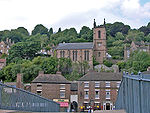Broseley
Civil parishes in ShropshireEngvarB from September 2013Ironbridge GorgeMarket towns in ShropshireTowns in Shropshire

Broseley () is a market town in Shropshire, England, with a population of 4,929 at the 2011 Census and an estimate of 5,022 in 2019. The River Severn flows to its north and east. The first iron bridge in the world was built in 1779 across the Severn, linking Broseley with Coalbrookdale and Madeley. This contributed to the early industrial development in the Ironbridge Gorge, which is now part of a World Heritage Site.
Excerpt from the Wikipedia article Broseley (License: CC BY-SA 3.0, Authors, Images).Broseley
Geographical coordinates (GPS) Address Nearby Places Show on map
Geographical coordinates (GPS)
| Latitude | Longitude |
|---|---|
| N 52.612 ° | E -2.481 ° |
Address
TF12 5EN
England, United Kingdom
Open on Google Maps










